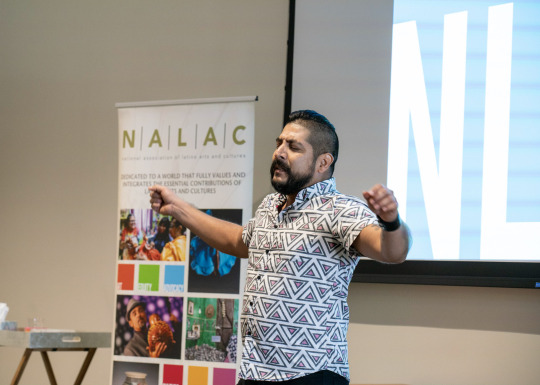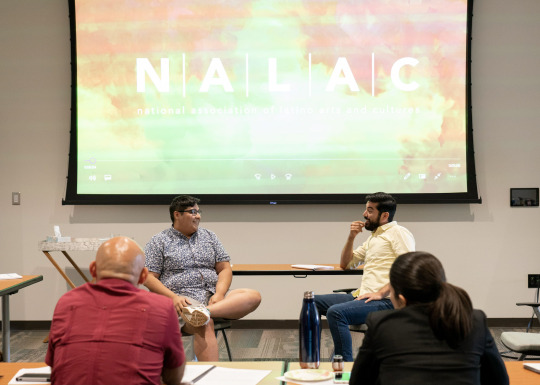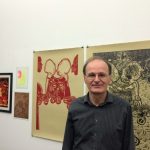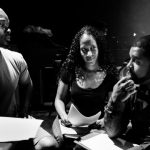Conversations | Alicia Ehni at NALAC Leadership Institute
NALAC Fellows talk to IAP Newsletter Editor about their lives as Latinx artists.
In July, IAP Newsletter Editor, Alicia Ehni, participated in the NALAC Leadership Institute (NLI), hosted by the National Association of Latino Arts and Culture, which delivers innovative and practical strategies to artists and arts administrators chosen from all over the country. Over the last 18 years, the Leadership Institute has developed a curriculum that is based on a historical overview and analysis of Latino arts and cultures in the U.S., including the vital role of community involvement.
Adriana Gallego, NALAC Chief Operating Officer and artist, comments about this year’s program: “Every year, the NALAC Leadership Institute strengthens the Latinx and inter-cultural artistic sectors with multi-generations of artists and arts leaders to bridge collaborations and alliances across ethnic, geographic, and intergenerational lines. This connectedness is critical in our pursuit for cultural equity, which will arise when diverse populations address social inequality together and work to create shared opportunities for access to resources, cultural participation, and artistic production.”
This year, 29 artists and arts administrators were chosen to participate in the NALAC Leadership Institute in San Antonio. A follow-up was conducted a month later with the 2018 Fellows to see how this program is impacting their careers and lives. Many of these Fellows are wearing multiple hats. This interview highlights the different voices of talented Latino artists who share their insights and strategies on successfully navigating their multiple roles.

NYFA: How do you see your role as an artist and leader after participating in the NALAC Leadership Institute (NLI)?
Christine Lamprea: I have a new perspective on my career as a classical cellist. I see possibilities of curating a more uniquely tailored concert season for myself, rather than trying to succeed in more traditional models of success in classical music. I feel more empowered to lean into my strengths, some of which stem from the history of my parents and their immigration story, as well as characteristics that stem from the beauty of Latinx culture.
Jaime Garza: NLI has been a very strong support system for me. The week-long intense immersion of Latino-based art and culture made me feel like part of something bigger than myself.
In Chicago, I’m known because of my work as a musician with the band Dos Santos and as an arts promoter, curator, and organizer of independent events. The role I play in Chicago is to help and support other artists and musicians. Attending NLI has given me skills and a wider scope of Latinx culture, that I hope to use to continue assisting local artists and myself, so we can create meaningful art.
Jessy De León: I’ve always known that music and art reflect a nation’s culture; however, through NLI I was able to see more clearly what the ones that came before us have done to preserve their Hispanic identity through the Chicano movement. NLI helped me realized that the non-profit I founded, Comparte tu Luz, was created not only to help communities understand the importance of art but also that artists have a responsibility to promote and preserve their culture, by remembering who they are and where they have come from. This is reflected in their art.
Johana Moscoso: After NLI I see my role as that of a connector who connects personal and intimate instances in daily life that affect our current society. Living in a small town in Wisconsin as a Colombian immigrant–who has a thick Hispanic accent and starts sentences saying ¡Ay!–has created an urgency in me to connect my workplace with immigrants who only speak Español, or as I grew up calling it, Castellano. This urgency has extended to my art practice.
For me, it is necessary to create art that critically reflects the Latinx culture as a vital component of American society, history, and art. I celebrate my Latinx culture by merging performance, video, sculpture, and fiber art into large-scale installations.
Michael Menchaca: I feel much more confident moving forward after NLI, with a better idea of what my artistic vision is and what I need to do in order to achieve my goals. I have started the groundwork to better organize my work schedule and prioritize my deadlines. The network of colleagues I made during the NLI fellowship has further motivated me to become a stronger cultural leader in the arts.
Paty Lorena Solórzano: After NLI, I felt an incredible sense of value and motivation to rise above the challenges that come from being in a field that lacks representation and equity for Latinx dance artists, especially for women of color!
I think there’s a lot that comes from validation–to feel that your work matters and that you can acquire the tools to make your work visible. It gives you power. I feel a greater sense of responsibility for my Latinx community in dance, and I hope to use the knowledge I gained at NLI to continue to advocate for and uplift other Latinx dancers and choreographers. We really need it!

NYFA: What concrete actions will you implement in your current work?
Christine Lamprea: One of the strongest metaphors from NLI was the season arc, where an artist can create subcategories to delve into and market. I imagined myself holding the arc like a little basket, and I could reach in and pull out one of my recital programs to tour, or a future commission, or another project. The sense of being the owner of my season, rather than a hopeful participant in others’ seasons, was an important mental switch for me. Currently, I am developing a curriculum for a summer festival for Latinx string players, in addition to building my performance career as a solo cellist and pedagogue.
Jaime Garza: The things I learned and plan to implement are organizational and involve stepping back to see the bigger picture. Basing my collaboration or actions on my values will help my workflow in a more positive way. Organizing in groups, teams, or communities invested in decision-making is a must. Community building and partnerships are where I am putting more work going forward, in conjunction with grant writing and resources research.
Suzy González: NLI inspired me to keep doing what I do but to be more organized and proactive in doing it. It taught me to push myself to achieve my goals. For each of my roles–as artist, curator, educator, publisher–I now have the tools needed to strategically formulate my vision, mission, and goals. This will help me progress in my field without getting distracted by work that does not get me where I want to be. It also restored my sense of confidence and the reminder to not sell myself short.
Johana Moscoso: I will work with communities during my creative process, and create public programming around my art pieces to help foster relationships. Currently, I am working on funding the Ingrid López Project. It is a large scale installation that includes sculptures, tapestries, video and/or sound, and the participation of López’s Florida community. It celebrates the life of my beloved family member Ingrid and how she touched many lives before her untimely passing. She helped immigrants, especially Latinx individuals, when they moved to the United States. She assisted in creating better lives for their families. To make this project, I will reconnect with her community in Florida and document people’s testimonies and turn them into my artwork. The project aims to uplift immigrant’s voices and evoke empathy around migration.
Paty Lorena Solórzano: I am in the beginning stages of Mapping la Monarca: Danzas Migratorias, a site-specific migratory dance work and long distance walk that will begin at the Monarch sanctuary in my native Michocán, and will traverse the journey of the butterfly to Michigan. It will involve scientific, social, and choreographic research on the movement of the butterfly, and connect metaphorically to social justice and discrimination towards migrant communities from Mexico and Central America.
The NIL training gave key tools that will help me with this and other future artistic projects. Specifically, the funding workshop gave me insight into the breadth of resources available for artists. I think I used to look narrowly at the artistic/dance community for support, and now I realize the importance of moving through and beyond other supporting networks. If I can also let my community know what I as an artist can offer them, they, in turn, can support the work I do in creative ways. So for this project, I’m really thinking about finding collaborations outside of my creative circles, and finding support in networks in and beyond the usual funding resources typically available.
Additionally, through NLI, I learned about the structures of arts organizations. For example, though I was familiar with the function of a board of directors, it was helpful to go through the mock exercise of a board meeting conducting business. Again, having that knowledge and then having the NLI faculty giving us tools, encouraging us to serve in a board and become advocates for art in our communities…that’s power. This is where decisions are made about the future of the arts in small and large scale ways, so the Latinx presence matters.

NYFA: The NLI program is very unique; it puts artists and arts administrators in the same room. How did you benefit from this program format?
Mario Mesquita: As an artist and administrator, I find it confusing to separate my roles. I am more comfortable with “cultural producer,” which encompasses both. Much of my art practice and chosen traditional-work involves creative ways to make change, including conversation, organized moments of exchange, reflection, brainstorming, and solution-making. Being in a room with like-minded individuals was nutritive and served to strengthen and fortify my role. With new, lasting relationships from this experience, my hope is to continue to investigate and take action using art as a tool for social change and education. At every stage–from funding, organizing, and implementing, I will encourage reciprocal dialogue and learning.
Johana Moscoso: I learned that my vision sustains my art practice and my job as a Residency Coordinator in the John Michael Kohler Arts Center’s Community Arts department. This institution funded my trip to the NLI, supports my bilingual work with the Latinx community, encourages new art in public spaces by Latinx women artists, and welcomes professionals from different ethnicities.
Meeting Latinx leaders was such an inspiring and phenomenal experience! With them, I found answers to questions that I never thought someone else would ask, or feel the necessity to share. Switching between English and Spanish, learning about the history of our “American Latinidades,” and being part of such an energetic and powerful community is an experience I will always remember.
Jessy De León: I am both an artist and arts administrator, and being in a room full of both allowed me to enhance my vision about art and the importance of distinguishing and separating both roles. As Executive Director, I’ve been so focused on getting the paperwork done lately that I had forgotten to devote some time to get creative, write new songs, paint, dance, etc… Both roles are so important and brighten and beautify Comparte tu Luz in different ways, where you see the same picture through different lenses that allow you to truly see the whole picture. The minute I got home I started applying this and I’ve written about 3 songs, created some beats, and will soon start rehearsing a new dance while also making sure we are moving forward with the paperwork. NLI was like laser surgery to enhance my blurry vision.
This interview is part of the ConEdison Immigrant Artist Program Newsletter #108. Subscribe to this free monthly e-mail for artist’s features, opportunities, and events.
– Interview Conducted by Alicia Ehni, Program Officer at NYFA Learning
All Images: Luis M. Garza, courtesy of NALAC.





